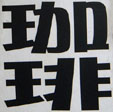


Orthographic Variation in Japanese as Seen in Public Notices and Advertising
'Orthographic variation' refers to different ways of writing the same word. This occurs in English too, as in the case of words with variant spellings, e.g., 'judgement' or 'judgment', etc.
But Japanese is a whole different ballgame. Japanese uses at least four different sets of graphical symbols to write the language:
1. Hiragana syllabary (phonetic, mainly used for grammatical endings and function words)
2. Katakana syllabary (phonetic, mainly used for foreign words, scientific biological names, and onomatopoeic words)
3. Chinese characters (kanji, used for 'content words' -- verbs, nouns, adjectives, etc., both native and Chinese based)
4. Roman letters (the English alphabet, used mainly for symbols and some foreign words)
With such a selection of scripts available there is remarkable leeway for writing words in different ways.
In fact, Japanese has always been relatively flexible about the way it represents words. Japanese writing originated with the imposition of an outside writing system (Chinese characters) on the language. Since the garment wasn't created for the language, the language had to come up with creative and flexible ways of wearing them. This has resulted in the flexible approach to writing that still characterises the modern language. (For more on this, see the Japanese writing system.)
This page looks at a selection of 'orthographic variants' found in signage and advertising in Japan, exemplifying some of the ways that the four scripts currently in use are creatively exploited for different purposes. Public signs and advertising probably represent orthographic variation at its greatest, but even sober prose, theoretically more standardised, shows considerable variation. The site Orthographic Variation in Japanese presents a systematic look at the ways in which 'spelling' can vary in Japanese.
This site brings together a random collection of real-world orthographic variants photographed in public signage and advertising during a few days in July and September 2003 (click on the links to see the actual examples).
For ocnvenience, this section is rather arbitrarily divided up according to what the 'correct' orthography should be. This approach takes as its starting point the idea that there is one way of writing a word that is inherently correct. While in many cases this view is justified, there are also many examples which are less clear cut, especially in the case of native Japanese words. To take one example, the word akasuri is treated as though it should be written in Chinese characters. In fact, aka is supposed to be written in hiragana according to the current rules (although there are many who still use the character). And verbs like suru are just as likely to be written in hiragana as in characters. Nevertheless, I've treated entries in the kun-yomi section as variants on a 'standard' Chinese character rendition.
Character compounds (on-yomi) rewritten in phonetic hiragana or katakana. Compound words normally written in Chinese characters (kanji) may be rewritten in phonetic hiragana or katakana for simplicity, emphasis, or other effects.
Characters written as hiragana
Annai: 案内, あんない
Chūi: 注意, ちゅうい
Gyōza: 餃子, ぎょうざ
Jitensha: 自転車, じてんしゃ
Kyūkei: 休けい
Manga: まんが
Mendō: 面倒, めんどう
Shadan-ki: 遮断機, しゃ断機
Shōyu: 醤油, しょうゆ
Characters written as katakana
Benri: 便利, ベンリ
Chikan: 痴漢, チカン
Gyōkai: 業界, ギョーカイ
Hifu: 皮膚, 皮フ
Keitai: 携帯, ケータイ
Kiken: 危険, キケン
Toku: 得, トク
Characters written as both hiragana and katakana
Kan: 缶, カン, かん
Kantan: 簡単, カンタン, かんたん
Keirin: 競輪, ケイリン, けいりん
Rāmen: らーめん , ラーメン
2. KUN-YOMI WORDS
Native Japanese words written in kana. It is only to be expected that on-yomi words or character compounds will be written in Chinese characters. On the other hand, native Japanese words (kun-yomi words) have never been quite as closely identified with Chinese characters.
Characters written as hiragana
Ichigo: いちご
Noriba: 乗り場, のりば
Suki-ma: すき間
Uriba: 売場, うりば
Yaki-tori: 焼鳥, やきとり
Verbs: Variation between characters and hiragana
Ama-mori: 雨漏り, 雨もり
Demashita: 出ました, でました
Fure-ai: ふれあい
Me-zasu: 目指す, めざす
Nobotte: 上って, のぼって
Osore/osoreru: 恐れ, おそれ
Otogi-sagashi : お伽さがし
Adoption of hiragana in writing kudasai, o-, -sama, etc.
O-kyaku-sama : お客さま, お客様
Kudasai : 下さい, ください
Characters written as katakanaAka-suri: アカスリ
Chikara: 力, ちから
Ha-burashi: 歯ブラシ, ハブラシ
Kasa: 傘, カサ
Yaki-niku : 焼き肉, 焼肉 , ヤキニク
Pronouns in katakana
Boku/Kimi/Ore/Uchi : ボク, キミ, オレ
Chinese characters written in both hiragana, katakana
Ha-gaki: はがき, ハガキ
Kagi: 鍵, かぎ, カギ
Kusuri: 薬, くすり, クスリ
Uso: うそ, ウソ
Ateji, etc. written as hiragana, katakana. Sometimes native Japanese words are written with characters in a makeshift manner. In 味噌 miso, the on-yomi is used for sound value and (partly) and partly for meaning. In other cases, characters are used for their meaning only (e.g., 大人 'large person' for otona). Sushi is a case where the same word is written in various ways in characters. However, in all of these cases, hiragana and katakana renderings can also be found.
Futari: 2人, 二人, ふたり
Miso: 味噌, みそ, ミソ
Otona: 大人, おとな, オトナ
Sushi: 寿司, 寿し, 鮨, すし
Suteki: 素敵, すてき
3. HIRAGANA WORDS
Hiragana words written in katakana. As seen above, there is some latitude in the choice of hiragana and katakana in representing words normally represented by Chinese characters. This also applies to words normally written in kana, which at times are written in katakana for emphasis or effect. Sometimes there is confusion over whether a word is a foreign word or a Japanese one, resulting in alternation between hiragana and katakana (see Tabako).
Koko: ここ, ココ
Sugu: すぐ, スグ
Tabako: たばこ, タバコ, 煙草
Taka-sa: 高さ, 高サ
Yori : より, ヨリ
Sometimes old-fashioned Chinese-character renderings are used to write words that are normally written in hiragana.
Made まで, 迄
Soba: そば, 蕎麦
4. KATAKANA WORDS
Foreign words: Although normally written in katakana, sometimes foreign words are written with the original English spelling.
Coffee: コーヒー, 珈琲, Coffee
Get: Get
Happy: ハッピー, Happy
Sex : Sex